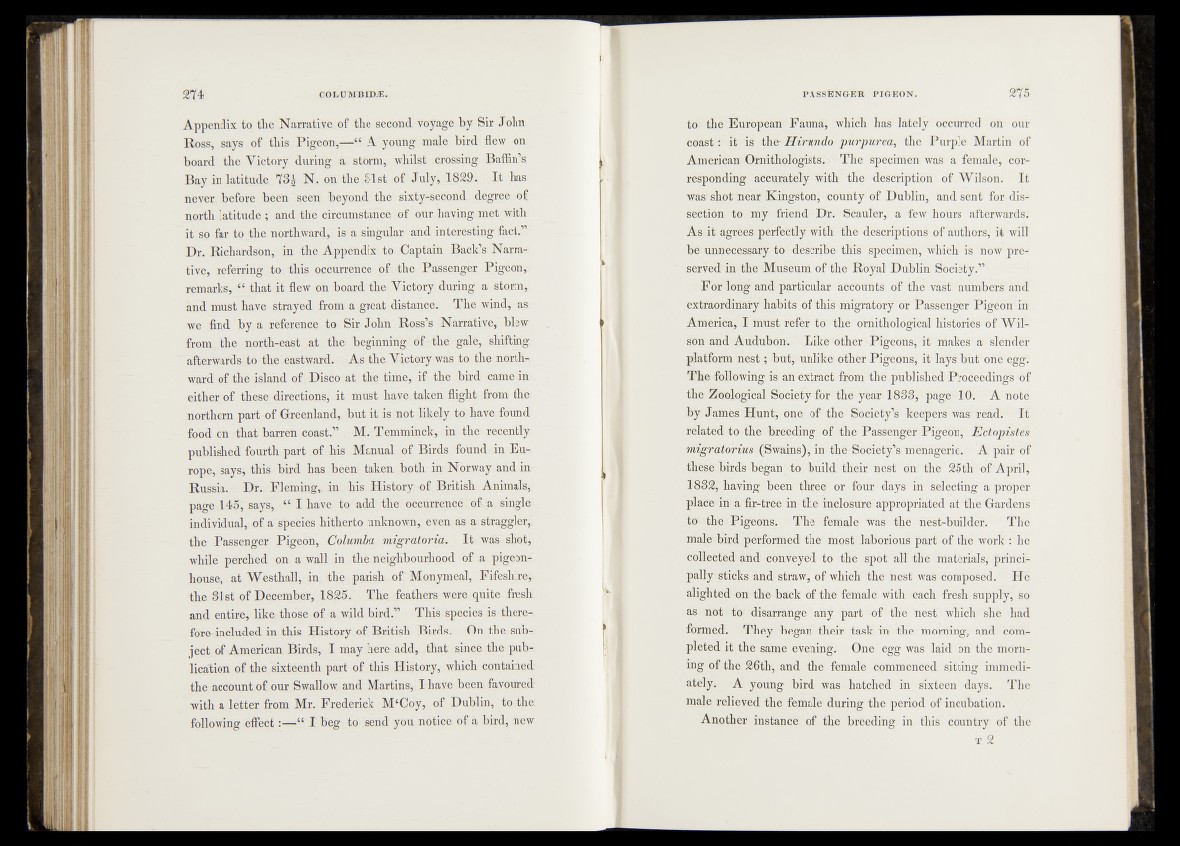
Appendix to the Narrative ;of the second voyage by Sir John
Ross, says of this Pigeon,-*-“ A young male bird flew on
board the Victory during a. storm, whilst .crossing Baffin’s
Bay in latitude 73^ N. on the 31st of July, 1829. I t has;
never before been seen beyond the sixty-second. degree. of
north latitude ; and the circumstance of our having met, with
it so far to.the northward, is.a singular and interesting fact.”
Dr. Richardson, in the Appendix to Captain Back’s Narra-!
five, referring to. this occurrence of the Passenger Pigeon,,-
remarks, “ that it flew on board the Victory during a storm,
and must have strayed from a great, distance. The wind, as*
we find by a reference- to Sir John Ross’s Narrative, blew
from„the north-east at „-the-.begjnnjmg^dC-^tó-- gale, Shifting
afterwards Jo the eastward. As the; Victory was ta Jhe north-,
ward of the island of. Disco - a t. th§. time, if the bird came in
either of these directions, it must have, taken flight; from this
northern part of Greenland, but it is not- likely j Jo- have found
food on that barren coast.” . M.- Temminck, in the-'recently?
published fourth part .of his Manual, of Birds .found in Eu-,
rope, says, this bird has been taken, both in Norway and in
Russia. Dr. : Fleming, in his History of ..British, Animals,
page 145, says, ‘‘ I have to' add the occurrence" oik#, singles
individual, of a speeies hitherto unknown, even as a straggler,,
the Passenge* Pigeon, Columba migratoria. I t was' shot,,
while perched on a wall in the neighbourhood of ,a pjgeon-
house, at Westhall, in, the parish o f Monymeal, Fifesb.ire,i
the 31st of December, 1825. : The, feathers were .quite fresh
and entire, like: those of a wild bird.” This. species is there-*
fore included in this History of. British Birds. On the sub-,
ject of American. Birds, I may here add, that since the pub-,
lication of the, sixteenth part of this History, which contained"
the account,of our Swallow and Martins,. I have been favoured'
with a letter from Mr. Frederick M‘Coy, of Dublin, to the,
following effect :— “ I beg to send you notice of a bird, new
to the European Fauna, which has lately occurred on our
coast : it is the- Hirundo purpurea^ the Purple Martin of
American Ornithologists.^ The specimen was a female, corresponding
accurately with the description of Wilson. It
was shot near Kingston, county of Dublin, and sent for dissection
to my fries# Dr. Scauler, a few hours afterwards.'
As it agrees perfectly with the descriptions of authors, ié will
be unnecessary to describe this specimen, which- is now preserved
in the Museum ofrtfie Royal Dublin Society.” -. '
Fo* long and particular accounts of the'.vast numbers'and
extraordinary habits- Of this migratory or Passenger Pigeon in
America, I must refer JoT-the ornithological historiés Of Wilson
and Audubo#Ip Like other Pigeons,-it make's a slender
platform nest ; btiti1 unlike5 other «Pigëb'ôs, it laÿs^ 'blit ohe egg.
The following, is an extract from the5published Proceedings of
the Zoological-Sboi%.ly fo^.the year* 1/888,& page-10. - A note
fry James Hunt,-one'of the S5ciëÉfs këë^ërk-was read. I t
related to the breeding ofvfche Passenger Pigeon," Ectopistes
Migrât or ius (Swains), inthe* Society’s in en agerief/' A pair óf
these birds began to build their "très#-bn -the" 25th of April,
188!2(, having b p ë # three or* four'days in selecting a proper
place in a fir-tree in the inclosufe"appropriated at the Gardens
tot the * Pigëóns". The female was the nest-biîildér. The
male bird performed' thè^most laborious part of thdVork : he
collected and COnyfeyfed- to the spot all the materials, principally
Sticks and straw, of which the nest was'composed. -' He
alighted on the back of ther fëmalè With fresh Supply, so
as not tóf disarrange any part of the;?-%^i which shè had
formed. -They began thfeir task in - fie morning/ and completed
it the same evening. One ’ egg was laid on the morning
of the 26th, and the female commenced sitting immediately.
A young bird was hatched in sixteen days. The
male relieved the female during the period of incubation.
Another instance of the brèeding in this country of the
t 2